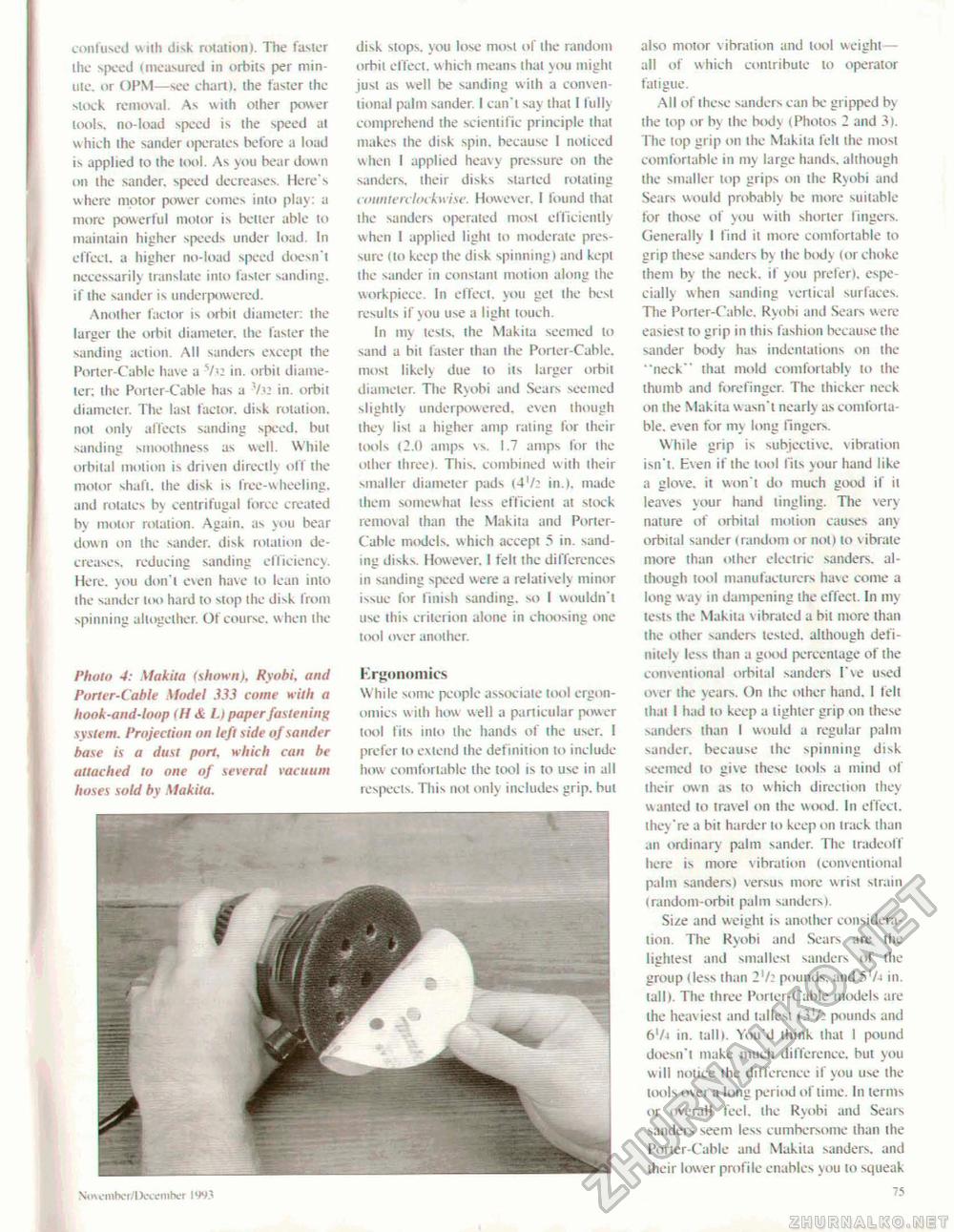Woodworker's Journal 1993-17-6, страница 75
confused with disk rotation). The faster the speed (measured in orbits per minute. or OPM—see chart), the faster the stock removal. As with other power tools, no-load speed is the speed at w hich the sander operates before a load is applied to the tool. As you bear down on the sander. speed decreases. Here's w here motor power comes into play: a more powerful motor is better able to maintain higher speeds under load. In effect, a higher no-load speed doesn't necessarily translate into faster sanding, if the sander is underpowered. Another factor is orbit diameter: the larger the orbit diameter, the faster the sanding action. All sanders except the Porter-Cable have a V<: in. orbit diameter: the Porter-Cable has a in. orbit diameter. The last factor, disk rotation, not only affects sanding speed, but sanding smoothness as well. While orbital motion is driven directly off the motor shaft, the disk is free-wheeling, and rotates by centrifugal force created by motor rotation. Again, as you bear down on the sander. disk rotation decreases. reducing sanding efficiency. Here, you don't even have to lean into the sander loo hard to stop the disk from spinning altogether. Of course, w hen the disk stops, you lose most of the random orbit effect, which means that you might just as well be sanding w ith a conventional palm sander. I can't say that 1 fully comprehend the scientific principle that makes the disk spin, because I noticed when I applied heavy pressure on the sanders. their disks started rotating counterclockwise. However, 1 found that the sanders operated most efficiently when 1 applied light lo moderate pressure (to keep the disk spinning) and kept the sander in constant motion along the workpiece. In effect, you gel the hesi results if you use a light touch. In my tests, the Makita seemed to sand a bit faster than the Porter-Cable, most likely due to its larger orbit diameter. The Ryobi and Sears seemed slightly underpowered, even though they list a higher amp rating for their tools (2.0 amps vs. 1.7 amps for Ihe other three). This, combined with their smaller diameter pads (41/: in.), made them somewhat less efficient at stock removal than the Makita and Porter-Cable models, which accept 5 in. sanding disks. However. I fell the differences in sanding speed were a relatively minor issue for finish sanding, so 1 wouldn't use this criterion alone in choosing one tool over another. November/lXx-emher IW Photo 4: Makita (shown), Ryobi, and Porter-Cable Model 333 come with a hook-and-loop <H Ll paper fastening system. Projection on left side of sander base is a dust port, which can he attached to one of several vacuum hoses sold by Makita. Ergonomics While some people associate tool ergonomics with how well a particular power tool fits into the hands of the user. I prefer to extend the definition to include how comfortable the tool is to use in all respects. This not only includes grip, but also motor v ibration and tool weight — all of which contribute to operator fatigue. All of these sanders tan be gripped by the top or by the bodv (Photos 2 and 3). The top grip on the Makita felt the most comfortable in my large hands, although the smaller top grips on the Ryobi and Sears would probably be more suitable tor those of you with shorter fingers. Generally I find it more comfortable to grip these sanders by the body (or choke them by the neck, if you prefer), especially when sanding vertical surfaces. The Porter-Cable. Ryobi and Sears were easiest to grip in ihis fashion because the sander body has indentations on the "'neck'" that mold comfortably to the thumb and forefinger. The thicker neck on the Makita wasn't nearly as comfortable. even for my long fingers. While grip is subjective, vibration isn't. Even if the tool fits your hand like a glove, it won't do much good if ii leaves your hand tingling. The very nature of orbital motion causes any orbital sander (random or not) to v ibrale more than other electric sanders. although tool manufacturers have come a long wav in dampening the effect. In my tests the Makita vibrated a bit more than the other sanders tested, although definitely less than a good percentage of the conventional orbital sanders I've used over the years. On the other hand. I felt thai 1 had lo keep a tighter grip on these sanders than I would a regular palm sander. because the spinning disk seemed lo give these IikiIs a mind of their own as to which direction they wanted to travel on the wood. In effect, they're a bit harder to keep on track than an ordinary palm sander. The tradeoff here is more vibration (conventional palm sanders) versus more wrisi strain I random-orbit palm sanders). Si a? and weight is another consideration. The Ryobi and Sears are the lightest and smallest sanders of the group (less than 21/: pounds, and 5V-i in. tall). The three Porter-Cable models are the heav iest and tallest (31/: pounds and 6'/4 in. tall). You'd think ihat 1 pound doesn't make much difference, but you will notice the difference if you use the tools over a long period of time. In terms or overall feel, the Ryobi and Sears sanders seem less cumbersome than the Porter-Cable and Makita sanders. and their lower profile enables you to squeak 75 |








